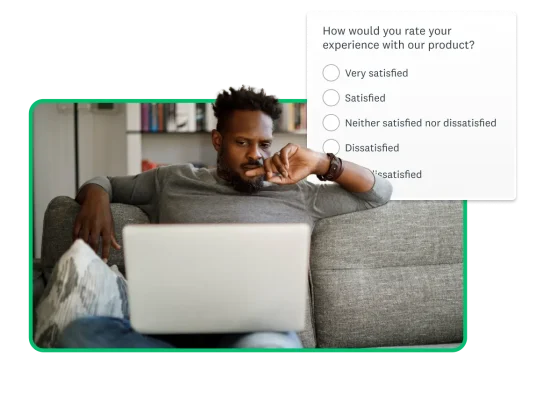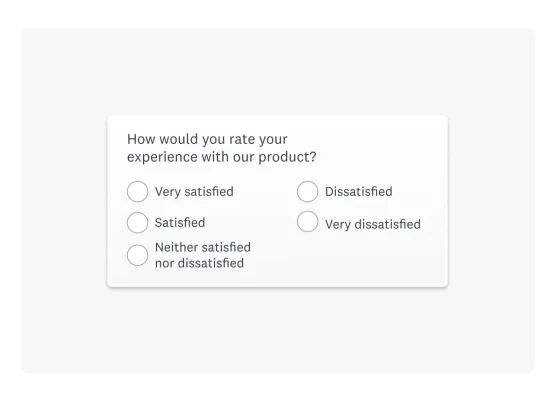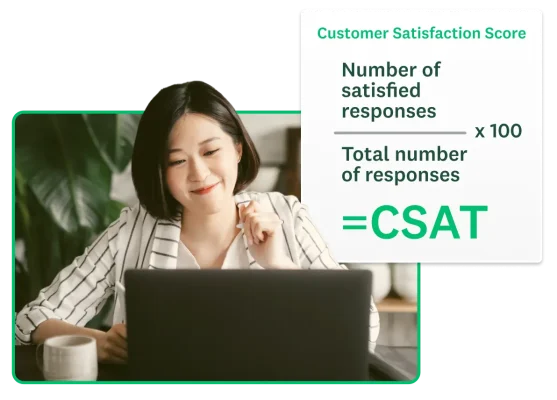50 customer satisfaction survey questions to strengthen CSAT
Strengthen CSAT with surveys. Use our expert-written customer satisfaction survey questions and free templates to better understand your customers.

We’ve all taken them. We’ve all abandoned poorly written, unclear, too specific, or too general customer satisfaction surveys. We opened the survey in good faith, ready to provide wisdom to the organization that seemed to care about our opinion, only to find leading questions geared toward receiving glowing reviews.
There is an art to writing an effective customer satisfaction survey. To that end, we’ve compiled 50 customer satisfaction survey question examples and tips to avoid common mistakes when crafting them.
What are customer satisfaction surveys?
Customer satisfaction surveys enable you to evaluate customer sentiment at a micro or macro level. This includes customers’ general level of satisfaction with your product or service, their experiences with your customer service, their happiness with your organization, and more. The Customer Satisfaction Score (CSAT) survey is the most popular customer feedback survey to measure satisfaction.
50 customer satisfaction survey questions
General satisfaction questions
- Please rate your overall satisfaction with [company].
- Is there anything else you'd like to share about your experience with [company/event/service/purchase]?
- What is one thing we could do to improve your experience with [company/service]?
- What would you suggest to help us improve our [product/service]?
- What is one thing we could do to improve your experience with [company/service]?
- On a scale of 1 to 10, how satisfied are you with [product/service]?
- Would you recommend [product/service] to friends and family?
- Is there anything else you'd like to share or suggest to help us improve our [product/service]?
Industry-specific satisfaction questions
Financial services
- How satisfied are you with our banking application process?
- How satisfied are you with the transparency of our financial [products/services]?
- Did our services meet your financial needs and goals?
Healthcare
- How satisfied were you with the level of care you received from our medical staff?
- How would you rate the cleanliness of our clinic?
- How satisfied are you with the appointment scheduling process?
- Please rate your level of satisfaction with the communication you received from our medical staff.
Food and beverage
- How would you rate your satisfaction with your recent visit to our restaurant?
- Did the ambiance of our restaurant meet your expectations?
- How would you rate the quality of the food and beverages you received?
- Were you satisfied with the attentiveness of the waitstaff?
- Were there any specific dishes or menu items that stood out to you? Please share.
Ecommerce
- Were you satisfied with the ease of navigating our website and finding the products you wanted?
- How satisfied are you with the checkout and payment process?
- Were the delivery and packaging of your order up to your expectations?
- How satisfied are you with the speed and reliability of our [delivery/shipping]?
Education
- Were you satisfied with the quality of instruction and course content?
- How would you rate the availability and accessibility of resources?
Hospitality
- How satisfied were you with your recent stay at our hotel?
- How satisfied were you with the cleanliness of your room?
- Were the amenities up to your expectations?
- How satisfied are you with the check-in and check-out experience?
- How likely are you to recommend our hotel to your friends and family?
Event satisfaction questions
- How would you rate your overall satisfaction with the trade show you recently attended?
- How satisfied are you with the communication you received from the event organizers?
- Were the staff and employees helpful and friendly during the event?
- How easy or difficult was accessing information and resources related to [event name]?
- Please share a memorable moment or experience from [event].
- How likely are you to attend [event] in the future?
Customer support satisfaction questions
- How would you rate your satisfaction with the communication you received from [department]?
- How satisfied were you with the response time of our customer support team?
- How would you rate the helpfulness of our customer service representatives?
- Rate your level of satisfaction with your recent customer service experience.
- Was your issue resolved to your satisfaction?
Website and mobile app satisfaction questions
- How would you rate your satisfaction with our mobile app?
- How easily were you able to navigate through our website?
- Were you able to find the information you were looking for?
- How satisfied are you with the checkout process on our [website/mobile app]?
- Did you encounter difficulties using our [website/mobile app?] Please explain.
Pricing and value satisfaction questions
- How satisfied are you with the pricing of our [product/service]?
- Do you believe [product/service] offers good value for the price?
- How satisfied are you with the [product/service] you received in exchange for the price you paid?
What is Customer Satisfaction Score (CSAT)?

The Customer Satisfaction Score metric is a measurement that determines how happy customers are with an organization, its products or services, and its capabilities.
CSAT asks: “How would you rate your experience with our (fill in the blank)?” where the responses range from “Very satisfied” to “Very dissatisfied.”
How to calculate CSAT

To calculate your CSAT score, divide the number of satisfied customers by all your respondents and multiply the result by 100. You’ll end up with a percentage; the higher it is, the more satisfied your customers are. Check out our ultimate guide to Customer Satisfaction Score to learn CSAT best practices, industry benchmarks, and more.
Related reading: Calculate customer satisfaction with our CSAT calculator
How to build good customer satisfaction surveys

Now that you know about the customer satisfaction survey questions you can ask, let’s talk about common mistakes when building the survey—and what you can do to correct them!
1. Using restrictive answer options
When your answers don’t include the response your participant wants, you’ve created a frustrated experience for your respondents. They now face with the decision to answer inaccurately, skip the question, or abandon the questionnaire altogether. Not very productive. To let your question be inclusive of all opinions, offer an “I don’t know” answer choice or an “other” textbox or comment field.
2. Asking two-part questions with only one response option
This question-writing mistake is as simple as it sounds. Take the following as an example:
- “Did you enjoy our service and new menu? Yes or no?”
What if your service was impeccable, but the food was lacking? If there’s no way for the customer to answer this question accurately, you’ll get skipped questions, or, perhaps even worse, inaccurate responses. Make sure you’re asking for one distinct answer per question.
Returning to our example, you can break up the prompt:
- Survey question 1: “Did you enjoy our service?”
- Survey question 2: “Did you enjoy our new menu?”
3. Requiring a response to every question
Yes, it would be great if every single question in your customer satisfaction feedback survey was answered thoughtfully and completely. That just doesn’t happen in the real world; people are busy and get distracted. Sometimes, a question is missed as an oversight, sometimes the respondent doesn’t want to provide the information, and sometimes they’re just confused by the question. If you require an answer to every single question—even the most rudimentary ones—you’ll find that many respondents will leave your survey. So keep the required questions to a minimum and let them skip what they want.
4. Asking too many questions
Don’t interrogate your kind participants with page after page of highly detailed questions about every facet of your business. Keep your client feedback survey as succinct as possible, and you’ll have a better chance of getting meaningful data. Remember, you can always do follow-up surveys, and you’ll learn more with each poll you do.
5. Forgetting the goal of the survey
It’s easy to ask a lot of questions in order to get the most information you can. But each survey should have a specific goal in mind, one that every question should help reach. Stay focused on your goal, and you’ll get valuable information.
6. Attaching opinions to the questions
It’s hard to be objective when you think your customer service is outstanding. Take a step back from what you think you know and let your shoppers do the talking. Avoid embellishing your questions with superlatives. Take the prompt:
- “How would you describe our friendly customer service representatives?”
This is a leading question as it describes the reps as “friendly.” As a result, it isn’t likely to provide accurate results. Instead, ask a focused question about an aspect of your customer service, such as:
- “How responsive or unresponsive were our customer service representatives?”
7. Getting stuck in the hypothetical
It’s hard for most people to accurately determine what they may or may not do in a hypothetical situation. Don’t fabricate customer service “what if” situations that may not have happened to the respondent. Instead, focus on uncovering real customer service issues.
For instance, avoid question prompts like:
- “If our customer service representatives were extremely responsive to your needs, would you give our business a higher rating?”
And instead, ask:
- “How satisfied or dissatisfied are you with the performance of our customer service representatives?
Pro tip: Use a Likert Scale rating question to ask customers to rate their experiences.
8. Writing complicated questions
If your participants have to read questions several times in order to understand them, or if they’re repeatedly asked to write essay-like responses, you’ll end up with a lot of abandoned questionnaires. Write questions that can be easily scanned and that don’t require a lot of time to answer.
To make this point more concrete, let’s compare two question prompts that are ultimately asking the same thing. Here’s one that’s direct and simple:
- “How responsive (or unresponsive) is our company in answering your questions?”
Now see what happens when you make it ultra-specific and long:
- “If you have used our website, phone system, or email help system in the past, did our customer service representative get back to you in a timely manner?”
9. Including unnecessary questions
You’re probably eager to collect as much information as you can from each survey, but avoid the temptation. Customer service surveys that veer off course and ask seemingly unrelated questions can distract or confuse the respondent, and in some cases, may even evoke suspicion.
The examples are seemingly endless. And can be anything from…
- “What do you like to do during your free time?”
to…
- “Are you happy?”
10. Using yes or no answer options
You could ask the following question with “yes” or “no” answer options:
- “Is our company professional?”
But there’s a subtle spectrum of positive and negative responses. To get even richer data, try asking a “how” question with available responses, like, “extremely professional,” “somewhat professional,” and “not at all professional.” In short, modify the question prompt to: “How professional is our company?”
Free online customer satisfaction survey templates
At SurveyMonkey, we’ve developed a collection of methodologist-certified customer satisfaction survey templates to get you started quickly and easily. Of course, you’re always welcome to customize the questions to make your survey as specific as you’d like.
Customer satisfaction template
Use this customer satisfaction survey template to measure consumer satisfaction with your company, product, and services. Use skip logic to allow your customers to answer questions about products or services they’ve used and gain insights for improvement.
Customer satisfaction with customer service survey template
See how your frontline customer service and support agents are doing. Measure customer service hold times, problem resolution, product/service knowledge, and representative attitude.
Business-to-Business survey template
This customer satisfaction survey template is designed for when your clients aren’t just clients, they’re businesses too. Identify how satisfied your customers are with your timeliness, professionalism, and service.
Discover more resources

Customer satisfaction survey templates
Explore our customer satisfaction survey templates to rapidly collect data, identify pain points, and improve your customer experience.

See how Ryanair collects customer insights at scale
Discover how Ryanair uses SurveyMonkey and its Microsoft Power BI integration to track 50K monthly CSAT surveys and improve customer experiences.

CSAT calculator: Measure and interpret customer satisfaction
Is your company meeting customer expectations? Use our free CSAT calculator to assess your Customer Satisfaction score and drive profits.

Customer Behavior Analysis: A Complete Guide and Examples
Read our step-by-step guide on conducting customer behavior analysis. Learn how to collect data and improve customer touchpoints.